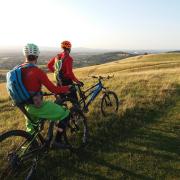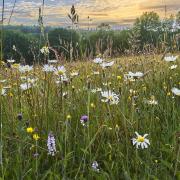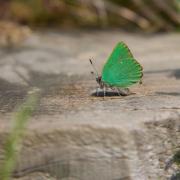It’s often said that Tetbury’s claim to fame is that it’s existed for over a 1,000 years – but, when it comes to folklore, not much seems to have happened there, save for the sad tale of how a cow called Moonlight was blown into the sky by a bomb during the Second World War! Given how difficult it can be to live in interesting times, does the lack of legend make Tetbury the most desirable place to live in the region? Certain members of the royal family have thought so! This month’s walk explores the quiet delights and hidden secrets of this market town.
Tetbury was founded in the reign of Ine, King of Wessex, in the late seventh and early eighth century. Although less well known than his indirect descendant Alfred, Ine was a lawbringer: he issued a code of laws that were still used in Alfred’s day 200 years later. He was a Christian who eventually abdicated his throne to go on pilgrimage to Rome. During his reign a woman called Tette, possibly his sister, became abbess of the nunnery here – and perhaps gave her name to the town that grew up around it. She may have been abbess at Wimborne in Dorset before coming to Gloucestershire and was said to be so strict in keeping men away from her nuns that she refused entry to even the Bishop! Tetbury sits on the borderlands between Wessex and the kingdom of the Hwicce, ruled by the larger kingdom of Mercia. A charter from the Mercian king Athelred granting land to the Abbey at Malmesbury provides the first mention of Tette’s monastery – and Tetbury’s motto, ‘Eternal things are more important than fleeting things’, from Athelred’s explanation of why he was giving land to the church.

Our walk starts by the original heart of Tetbury, the castle mound and parish church. The mound may possibly go back beyond the Saxons to the Iron Age, but history is slippery: was this mound a prehistoric fortification, a Saxon monastery, a castle, or a later pleasure ground? Or all those things? In the 12th century, anarchy swept across the land as Empress Matilda, daughter of King Henry I, rose up against Stephen, the old king’s nephew, who declared himself king after his uncle’s death. Matilda’s half-brother, Robert of Gloucester, backed his sister. Stephen and Robert’s armies clashed many times in the southwest, and maybe here in Tetbury, where Robert may have fortified the hill.
Walk across the bridge then head underneath it to get a sense of how high the town stands above the brook that once must have watered it. Crossing under the bridge, head up again and turn left along West Street. Notice the house name ‘Drover’s Cottage’; Tetbury was on a major route for driving sheep from west to east and became, like many other Cotswold towns, rich from the wool trade. More on the wool later! Turn right past the Victorian church, St Saviour’s, built as ‘a little church for the poor’ in the 1840s, then turn right down Long Street. You could visit the healing well, Magdalen Mead Well, off the London Road, once, fleetingly, the home of the Cistercian abbey that was later moved a few miles away to Kingswood. Now in Tesco’s car park, the well was a healing spring and a petrifying well: if you placed objects in it, they would turn to stone – or at least get covered in minerals from the spring so that they appeared to do so.
Cross the road and head downhill past the Snooty Fox, then turn left on to Gumstool Hill, scene of the Woolpack Race in which relays of people run up and down the hill with a 27 kilogram woolsack on their shoulders! In the 17th century this might have been a way of impressing the girls, but today women take part, though they carry a woolsack of a ‘mere’ 16 kilos (that’s the equivalent of four swords like the one Penny Mordaunt carried at the coronation).

The race is run between two old pubs, the Royal Oak at the bottom of the hill and the former Crown at the top, suggesting that alcohol may have fuelled the young drovers and townsfolk when the tradition started, possibly as far back as the days of the medieval wool trade. Revived in 1972, the race takes place at Whitsun and was revived in the early 1970s, but at the time of writing it seemed that it might not happen this year. At the bottom of the hill is what was once the Horsepool, the town pond, where horses could drink and from which Gumstool Hill got its name: there was said to be a ‘gumstool’ or ducking stool for ‘scolds’ – whom we now celebrate as ‘difficult women’ – badass women who wouldn’t shut up!
The street also has a small link with one of the most barbarous episodes of King John’s reign, when the lord of the manor of Tetbury, William de Braose, one of John’s favourites, fell out of favour, perhaps because of his knowledge of the killing of John’s nephew, Prince Arthur of Brittany, who also had a claim to the throne as the eldest son of John’s elder brother Geoffrey. Maud, William’s wife, apparently bandied it about that John had had the young man murdered. She was a formidable woman who legend says built the castle of Hay in Monmouthshire single-handed in a single night, carrying the stones in her apron. William fled, but Maud and their son were captured, and imprisoned with no food or water. It’s said there were bite marks on the son’s face when the bodies were removed. John is said to have had some remorse about this and gave land so that William and Maud’s daughter, Margaret, could found a priory to pray for their souls. Land was given to raise money for the priory by the family, too, including several properties on Gumstool Hill – a small atonement for family wrongs.
From Gumstool Hill, turn right over the stream towards the Goods Shed, then left on to the old railway line, closed by the Beeching cuts in the early 1960s and reopened as a footpath in 2000. Follow the path through the wood for about a half a mile, then take the first left turn into a small wood and walk through that until you emerge into water meadows. Follow the trail across the brook, then take the first left again. As you come on to a small track, turn left and you’ll see a small stone structure: this is Tetbury’s other spring, the Worwell, the source of the Tetbury Avon. In 1496 the people of Tetbury were granted the right to take water freely from the well, meaning that, although it’s an uphill hike back into town with full pails, there was water for all during the summer when the other wells ran dry.

Tetbury has other watery connections too. Wherever you look, you can find dolphins. Walk back along Cirencester Road and, when you get to the Chipping, turn up the steep steps to go into town. Crossing the Chipping car park, you’ll emerge near the Market Hall. On brackets all around the hall you can see dolphins, which appear in the town coat of arms. Tetbury is nowhere near the sea, so why dolphins? It seems that Tetbury folk were saved by dolphins not once, but twice. One member of the de Braose family was sailing across the Irish Sea when something from under the waves holed the ship in two places. Terrified, the sailors and passengers fell to their knees and prayed. As if by a miracle, the ship stayed afloat long enough to get back to land. As the ship pulled into port, two dolphins were spotted leaning up against the holes to stop them. When the ship was safe, the dolphins swam away. Centuries later, a ship carrying much of the town’s not inconsiderable wealth foundered near the coast of North America, and once more the dolphins swam in to save the ship. It’s sometimes said that dolphins are the souls of those drowned at sea, so perhaps they wished to save others from the same fate.

ESSENTIALS
Distance: 3 miles.
Duration: 1.5 hours.
Level: Easy; some road walking and some fields may be boggy.
Parking: Church Street car park.
Toilets and refreshments: The Royal Oak and many other places to eat and drink.
Transport links: Bus 882 to Cirencester via Kemble railway station; bus 69 between Stroud and Bath.
LINKS
Route: gb.mapometer.com/walking/route_5453064
Tetbury Rail Lands Regeneration Trust: tetburyraillands.org/tetbury-trail
Woolsack Races: merlinfraser.wordpress.com/tag/tetbury
Kirsty Hartsiotis is based in Stroud and available as a storyteller and speaker. She is an Accredited Arts Society lecturer. Her books include Wiltshire Folk Tales and (with Anthony Nanson) Gloucestershire Ghost Tales and Gloucestershire Folk Tales for Children. She is also the curator of decorative art at a Gloucestershire museum.



























